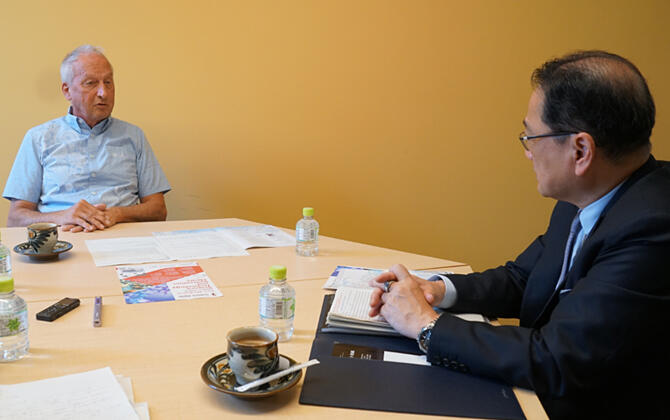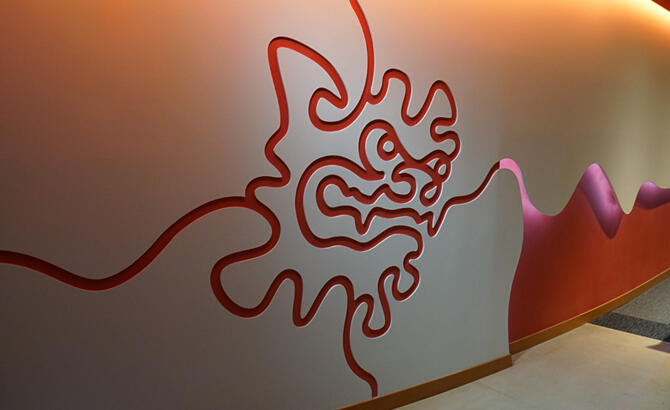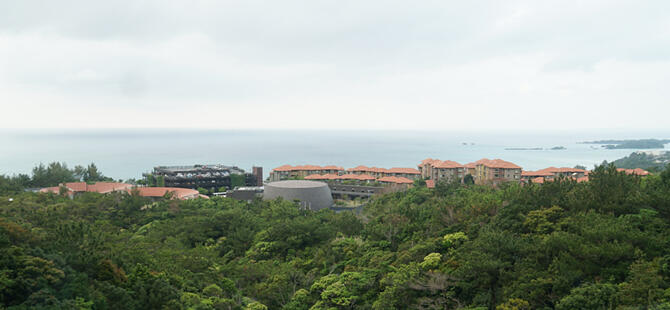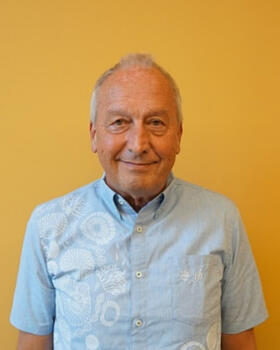Promoting international research mobility and creating international talent circulation is an essential condition for robust research and development. To this end, it is important to internationalize the research ecosystem, promote international human resource exchange, and ensure that Japan is firmly integrated into the international brain circulation network. Under this special topic, we will introduce the current status and challenges of Japan's research efforts to promote international brain circulation to produce outstanding research results as well as the attractiveness of Japan's research environment, which is the key to attracting foreign researchers, through a series of interviews with relevant people in the field.
In this interview we spoke to Dr. Peter Gruss, former president of OIST.
As another spring arrives in Japan, the world‐famous cherry trees bloom across the country. They are a well‐known symbol of new beginnings and draw large numbers of tourists every year. These flowers also bloom coinciding with the yearly movement of students and professionals studying and working in Japanese schools, universities, and businesses, both internally and those moving to new companies and organizations.
Looking deeper into this circulation of people in Japan, one university that stands out is the Okinawa Institute of Science and Technology (OIST), which plays host to a high percentage of foreign national researchers and has a unique organizational structure. Its attractive location and international mindset have led to significant scientific outcomes since its accreditation in 2011.
Dr. Peter Gruss, who recently retired from his role as president of OIST and now serves as its special advisor for innovation, welcomed us to his sunny office on campus to speak about his time at the institute, Japan as a place for research, and international human resource mobility, known as "international brain circulation," here in Japan.

OIST is a unique and competitive international research institute
You had a brilliant track record before coming to OIST. Could you share what led you to choose Okinawa, how you felt about serving in a leadership role in Japan, and your mission during your time at OIST?
I visited Japan quite often as the President of the Max Planck Society, but never Okinawa. I came here for the first time as part of the presidential recruitment process.
First, I think we need to understand that science is international. There is no such thing as "national science." The benchmark is to be international, and I had the feeling I could facilitate internationally competitive science at OIST.
At the Max Planck Society, which is one of the most successful basic science research institutions in the world, we turned out many Noble Prize laureates during my term as President. I found the principles of OIST to be closely related to those at the Max Planck Society. We are both very international, and we are both funded through a mechanism that I call "high‐trust funding."*1 Interestingly, Max Planck has operated using high‐trust funding for the entirety of its existence.
Okinawa is a unique place in Japan with a different history compared to the rest of the country. Our political founding father was Mr. Koji Omi, who assumed two ministerial posts (as Minister of State for Okinawa and Northern Territories Affairs and Science and Technology Policy) under the Koizumi Administration. He got together with Dr. Arima Akito, Professor Emeritus of the University of Tokyo, who served as both Minister of Education and Director General of the Science and Technology Agency, to discuss a new type of university in Japan, but they quickly came to the conclusion that the existing university system would not be easy to reform. Instead, they proposed the creation of a new university.

OIST's success is being recognized more widely in Japan and throughout the world. What do you consider to be the principal factors to its success?
Funding is crucial for a science research institute like OIST, and we have very clear principles when using this investment. We only want to hire the best scientists in the world. People around the world often look at success from the perspective of awards received. We recently had a Nobel Prize laureate, Dr. Svante Pääbo, and I have never seen so many cameras here in a single day! Whether you like it or not, these types of awards and measurements tell the public that the investment we receive is being well spent.
As I mentioned, we are very international and are funded through a mechanism called "high‐trust funding." Every faculty is given five years' worth of funding. In the fifth year, we organize a review by five international referees who review the performance of each faculty. Ultimately this funding is either maintained, increased or reduced. That's the way it should be done. So, the first real key factor is that OIST gives high‐trust funding to the faculty members to give them to freedom to follow their curiosity.
On top of this, we give our researchers internationally competitive salaries. Salary is the second most important factor.
The third factor is language. English is the lingua franca in science. In OIST, English is used universally, even in our administration. The composition of faculty is also very international. At OIST, 63% of our faculty are non‐Japanese and we have 1,090 employees from 63 countries and territories.
To illustrate our international impact, about 64% of our publications are co‐authored with collaborators from outside Japan. We have a very strong international network, working with colleagues from a wide range of countries.
Leading Japan back to the cutting‐edge of science, technology and innovation research
Looking at OIST's success, how can the Japanese system be improved to see results like this at other institutions?
The fundamental question is, Do you want the Japanese system to be "fast followers" in research, meaning you wait for someone else to try something and then you imitate it? This way of thinking makes no sense to me because it raises another question, Why are you doing science? It seems to me that reformation is needed in the academic system, both on the structural and funding sides.
Young researchers should be given independence, and the faculty members here at OIST are completely independent. This is a key issue in Japan — an assistant professor should do his or her own work, and not assist the professor. If you look at the work done for previous Nobel Prizes, many of the ideas have begun developing at the age of about 38. This gives you some food for thought in Japan. The new ¥10 trillion university fund program that the Japanese government is going to establish is a good step towards change.
My image of Japan is that it is a country that cherishes knowledge and people, like we Germans. Germany gives great support to science. I was previously the Chairman of the Siemens Science and Technology Board and was often told, "We have many big companies that spent money on R&D." This is an important point, but the issue is where they spend it. It is spent on areas they are interested in. You will not get breakthrough innovation in a new field based on funding from a single company, or from the venture capital of a big player in the industry because research into these areas is not in their interest.
Unless you take the route of startups and generate a lot of venture capital, which then attracts entrepreneurs to make a startup, this situation will not change. Incremental innovation comes from the big companies. But breakthrough innovation, which is completely new things, comes mostly from entrepreneurs.
It seems like you are satisfied with what you achieved during your six‐year tenure, but do you have any unfinished business?
I worked hard on getting a new building for an incubator. If you want startups, you need intellectual property (IP) as a seed for business, but unless the university is providing it, where is this coming from? This point is often neglected. It is very simple as to why this is important. OIST was successful in attracting venture capital in the range of about ¥5 billion, which will translate into support for 40 to 60 startups. With this amount of money, we will bring entrepreneurs to Okinawa and OIST once have a space for them. A new building will be constructed to accommodate more entrepreneurs to come to OIST.

Provided by OIST
Even after leaving the post of President, will you continue to be involved with OIST and Okinawa?
I was asking myself how I could continue to help OIST and Okinawa. This links well with the third pillar of OIST — innovation. As I mentioned earlier, the first is research. We are doing very well in this area. The second is education and we get good students from all over the world. The third pillar is innovation, which is an important way that we can contribute to the development of Okinawa.
The return on investment in research is not great unless it prepares society for the challenges of the future, such as COVID‐19, or creates tangible impacts on economic growth. That is what I am involved with now. I have taken on a very complex role to invite entrepreneurs to come to Okinawa and bring their startups here, while working together with OIST as an intellectual center.
With this project, I hope startups will provide new well‐paying jobs and provide a return on investment that will stretch for 5 to 10 years to come in Okinawa. OIST is needed in Okinawa as an intellectual center and a driver of commercialization. This will hold most of the innovation activities in Okinawa and is one of the things I want to promote.
In order to attract global entrepreneurs to Okinawa, we're already running a program called OIST Innovation Accelerator Program and have financing from the Okinawa Prefectural Government. We are advertising with the goal of getting people to apply from other countries. There is a selection process, which, in this case, is not done by scientists, but by businesspeople.
I can give you a very successful case study originating from OIST. A company called EF Polymer was created by a young entrepreneur from India and has received a number of awards, including the one from the Japanese Ministry of Environment. They have some unique and excellent achievements. The company converts organic waste into a polymer that looks like a gel, and when this substance is placed under the soil it retains water, which is a perfect for growing plants in drier countries. The company grew at an amazingly fast rate, and is continuing to do well. If we provide funding and space, and an intellectual environment, we could attract other people from overseas to come as well. This is similar to what I said about the science, and it is also true for entrepreneurs as well.
"International brain circulation" and the importance of it benefiting the community
You emphasized its international nature, but is OIST oriented towards the Asia and Pacific region, or more globally?
OIST is not oriented towards any particular region, but half of our current students come from the Asia‐Pacific area, which is a substantial fraction.
Again, I think that Japan should strive to open further and become more international. There is a very similar problem in Germany, which is language. No one learns German these days and many German universities teach in English after the undergraduate level. If you build bridges, you can bring in people, and if people come when they are young, they will learn Japanese to move on to the local job market. However, if these bridges are not built, the number people moving to Japan and learning the language will be small. But the reality is that English is the lingua franca and everyone has to learn it. If you don't learn English, you cannot work in science.
I am absolutely positive that if more emphasis was placed on promotion, you would get more talented people from the Asia‐Pacific region moving to Japan. Most countries in the region do not have a well‐developed science funding system. However, you will never be able to ignore the language issue. Something must be done to help with the language. You have to do something that enables international talent to enter into and survive in the Japanese system.
(Interviewer: Yoshihiro Higuchi, Director for Global Strategic Issues, JST)
Afterword
The international nature of OIST and its funding structure make it unique among research institutes in Japan. The high percentage of international researchers and the world‐leading results it has achieved provide a fantastic example of the benefits of "international brain circulation," and a great model for other institutes to follow as they look towards the future.
Dr. Gruss' passion for research and innovation and his hopes for positive outcomes at OIST are drivers of his success. During our conversation, he did not hesitate to express his frank opinions about the current Japanese system and to make suggestions to bring about changes for the better. We hope to hear more about his successes in fostering innovation at OIST and the wider Okinawan community in the future.


Profile
Peter Gruss
Special Advisor for Innovation, Okinawa Institute of Science and Technology Graduate University
After a distinguished career in research, Dr. Gruss moved into the role of president of the Max Planck Society, Germany from 2002‐2014. Following this he took on the position of President of OIST, serving from 2017‐2022. He moved into his current position as Special Advisor for Innovation earlier this year.
<About OIST>
The Okinawa Institute of Science and Technology (OIST) is a graduate university dedicated to conducting world‐leading research, growing the next generation of scientific leaders, and fostering innovation and sustainable economic growth in Okinawa. Since its founding 11 years ago, OIST has gained recognition in the international scientific community. When normalized for size, the university ranks among the top ten institutes in the world for high‐quality and high‐impact scientific research outputs.
*1 High‐Trust Funding: To deliver world‐leading research, OIST recruits some of the most talented faculty members, researchers, staff, and students from Japan and around the world. It is able to attract top scientists by providing scientific freedom. OIST believes breakthroughs happen when they invest in top scientists and let them follow their curiosity. Each faculty member, from junior to senior, leads an independent research unit with their own budget and is responsible for their own research program. Each unit is provided "high‐trust" funding to pursue bold and novel directions. Every five years, the research results are subject to a rigorous external review to ensure the investment is leading to results of the highest scientific standards.
OIST homepage: https://www.oist.jp/
Produced by the Science Japan Editorial Team




